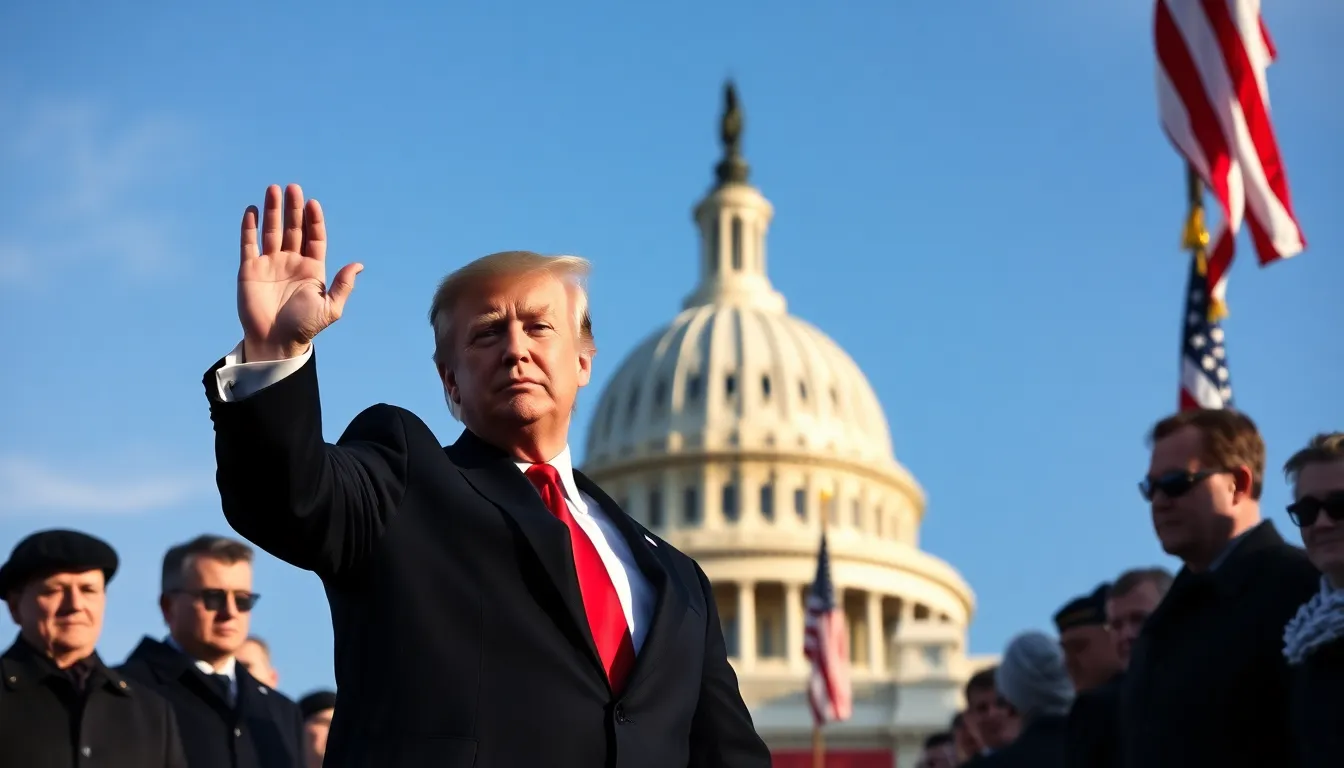Table of Contents
ToggleDonald Trump’s presidency marked a significant turning point in American politics. He took office on January 20, 2017, after a highly contentious election that captivated the nation. His rise from a business mogul and reality TV star to the 45th President of the United States shocked many and sparked intense debates about leadership and policy.
As he entered the White House, Trump brought with him a promise to “Make America Great Again,” which resonated with millions of voters. His inauguration set the stage for a presidency characterized by bold decisions, controversial statements, and a unique approach to governance that would leave a lasting impact on the political landscape. Understanding when Trump took office is crucial for grasping the events that followed during his tumultuous four years in power.
Overview of Trump’s Presidency
Trump’s presidency commenced on January 20, 2017. He entered office following a highly contentious election marked by deep political polarization. Trump’s background as a business mogul and reality TV star introduced a unique dynamic to the presidency. His campaign slogan, “Make America Great Again,” appealed to a significant segment of the American electorate, influencing voter sentiment and engagement.
His administration focused on economic policies, emphasizing tax cuts and deregulation. The Tax Cuts and Jobs Act of 2017 reduced corporate tax rates from 35% to 21%. During his tenure, unemployment rates reached a 50-year low at 3.5% in 2019.
Trump’s foreign policy displayed a distinct approach, including the withdrawal from the Paris Climate Accord and the Iran nuclear deal. He emphasized “America First” in diplomatic relations, leading to strained alliances and altered trade agreements, such as the United States-Mexico-Canada Agreement (USMCA) that replaced NAFTA.
Contentious decisions characterized Trump’s presidency, often leading to widespread debate and protests. His administration’s handling of immigration policy, particularly the travel ban and family separation policies at the U.S.-Mexico border, sparked significant controversy and legal challenges.
Trump oriented his presidency around a strong use of social media, primarily Twitter, directly communicating with the public and shaping narratives. His unfiltered communication style both energized his supporters and alienated critics.
These factors, along with numerous investigations and impeachment proceedings, defined Trump’s time in office. The impact of his presidency continues to evoke discussions surrounding American politics and governance.
Inauguration Day

Inauguration Day marks the official beginning of a president’s term. For Donald Trump, this day occurred on January 20, 2017, and it signified a major shift in U.S. politics.
Date and Significance
January 20, 2017, became a pivotal date in American history as Donald Trump took the oath of office, officially becoming the 45th President of the United States. This inauguration followed a highly polarized election season, reflecting deep divisions in the electorate. Trump’s ascendance symbolized a populist movement within the Republican Party, emphasizing a shift toward nationalism and a departure from traditional political norms. The event also signaled Trump’s commitment to his campaign promises, particularly those focused on economic revitalization and immigration reform.
Ceremony Highlights
The inauguration ceremony featured several notable highlights. Donald Trump took the oath of office administered by Chief Justice John Roberts. The event included performances by several artists, including the Radio City Rockettes and Jackie Evancho, who sang the national anthem. Following the ceremony, Trump delivered an inaugural address focusing on themes of American renewal and populism, famously declaring, “The forgotten men and women of our country will be forgotten no longer.” The day concluded with a series of inaugural balls, celebrating the new administration and marking the beginning of Trump’s presidential journey.
Early Days in Office
Trump’s early days in office set the tone for his presidency, marked by swift actions and notable appointments that shaped his administration’s direction. These initial weeks encompassed a flurry of executive orders and key personnel selections that underscored his agenda.
Executive Orders and Actions
Trump signed 20 executive orders within his first month, pursuing bold policy changes aimed at fulfilling campaign promises. Key actions included:
- Border Security: Implementation of measures to enhance immigration control, including plans for constructing a border wall between the U.S. and Mexico.
- Regulatory Rollbacks: Actions aimed at reducing federal regulations, including a directive to eliminate two regulations for every new one introduced.
- Withdrawal from Trade Agreements: Immediate withdrawal from the Trans-Pacific Partnership (TPP), highlighting a protectionist approach to trade.
- Approval of Pipeline Projects: Greenlighting the Keystone XL and Dakota Access Pipelines, supporting energy infrastructure development.
These executive orders reflected Trump’s commitment to “America First” policies, igniting significant debate and opposition across the political spectrum.
Key Appointments
Trump’s appointments filled various government positions, shaping the administration’s priorities and tone. Notable selections included:
- Jeff Sessions: Nominated as Attorney General, Sessions focused on a tough-on-crime stance and prioritized immigration enforcement.
- Reince Priebus: Appointed Chief of Staff, Priebus was tasked with managing internal administration operations and legislative objectives.
- Mike Pence: Selected as Vice President, Pence played a crucial role in advancing Trump’s agenda and maintaining party unity.
- Ben Carson: Appointed as Secretary of Housing and Urban Development, Carson emphasized affordable housing initiatives.
These appointments signaled Trump’s intention to assemble a team aligned with his vision, often prioritizing loyalty and conservative principles over traditional political experience.
Political Climate During Inauguration
The political climate surrounding Trump’s inauguration on January 20, 2017, reflected a nation deeply divided and politically charged. Public reactions and media coverage during this period underscored the contentious atmosphere marking the beginning of his presidency.
Public Reactions
Public reactions varied widely, reflecting significant political polarization. Supporters celebrated Trump’s promise to challenge the status quo, with many attending the inauguration and expressing optimism about his “America First” agenda. Conversely, opposition groups organized protests, including the Women’s March the day after the inauguration, which drew millions in cities across the country. Demonstrators highlighted concerns over Trump’s policies and rhetoric, emphasizing issues such as women’s rights, immigration, and civil liberties. Polls from January 2017 indicated that Trump’s approval ratings were among the lowest for any incoming president, with approximately 40% of Americans expressing approval of his presidency at that time.
Media Coverage
Media coverage during Trump’s inauguration highlighted the stark contrast in perceptions between supporters and critics. Major news outlets provided analyses on the significance of his rise to power, labeling his presidency a populist movement. Coverage of the inauguration focused on the ceremony, including Trump’s inaugural address, which emphasized themes of economic renewal and nationalism. Reporters also scrutinized the attendance figures, with Trump’s team claiming a record crowd, while images and Metro ridership data suggested otherwise. This disparity in narrative fueled ongoing debates regarding truthfulness in media and government, establishing a framework for Trump’s complicated relationship with the press throughout his presidency.
Impact of Taking Office
Trump’s presidency initiated significant changes both domestically and internationally. His administration’s actions and decisions marked a pivotal transformation in U.S. politics, influencing various aspects of governance.
Domestic Policies
Domestic policies implemented under Trump focused heavily on economic reform. The Tax Cuts and Jobs Act of 2017 lowered corporate tax rates from 35% to 21%, contributing to a historic unemployment rate of 3.5% by 2019. His administration prioritized deregulation, rolling back numerous environmental and labor regulations to stimulate business growth. Trump’s immigration policies, including the travel ban affecting several Muslim-majority countries, generated intense public criticism. Additionally, policies like the “zero tolerance” immigration approach led to family separations at the U.S.-Mexico border, sparking nationwide protests and debates surrounding humanitarian issues. Increased funding for law enforcement and the promotion of criminal justice reform efforts also characterized his domestic agenda.
Foreign Relations
Trump’s foreign relations strategy emphasized an “America First” approach, challenging long-standing diplomatic norms. His withdrawal from the Paris Climate Accord in 2017 and the Iran nuclear deal marked significant shifts in U.S. foreign policy, prioritizing national interests over multilateral agreements. The administration renegotiated trade deals, including the USMCA, replacing NAFTA to secure better terms for American workers. Diplomatic relations with North Korea, highlighted by high-profile summits, aimed to de-escalate tensions despite facing skepticism. Furthermore, Trump’s rhetoric and approach often strained relationships with traditional allies, creating an unpredictable global stance that redefined U.S. engagement in international affairs.
Donald Trump’s presidency, which began on January 20, 2017, marked a transformative era in American politics. His unique background and bold policy decisions reshaped the political landscape, igniting passionate debates across the nation. The inauguration not only signified a shift in leadership but also highlighted a divided electorate eager for change.
As Trump’s administration unfolded, it became clear that his approach would challenge traditional norms and provoke strong reactions both domestically and internationally. The implications of his presidency continue to resonate, influencing ongoing discussions about governance and the future of the Republican Party. Understanding this pivotal moment is crucial for grasping the current state of American politics.




